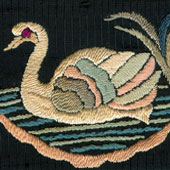Design Resource
Parsi Embroidered Sari Borders
History of Embroidery on Silk
by
1. In the Chinese embroidered borders with typical Chinese motifs of peonies, cherry blossom trees, pagodas, Chinese ladies at leisure, acanthus leaves, pebbled pathways and pretty clouds the most preferred embroidery stitch seems to be the satin stitch. This stitch performed the dual purpose of covering large areas of the fabric quickly while giving a rich texture that gave a tangible feel to the design. This rendering added value to the designs enriching the emotional response of the wearer to the embroidery on the fabric.
2. In the Chinese embroidery with European motifs like swans or ducks, lily pads, reeds on a pond, running water, etc. the stitches were also European. Thus the knot stitch and the couching stitch were introduced into the elements that formed the designs that were obviously meant for the European market or the Indian market that was under European influence.
3. Cross stitch embroidery with typical English floral motifs like roses, daisies and other floral sprays was done on matte cloth and was probably rendered on paper stencil designs. The cross stitch seems popular on black fabric, although Parsis considered black an inauspicious colour rarely worn outside of funerals and memorial prayer services.
4. A combination of several stitches was employed in borders embroidered and then cut out in stylised patterns of pineapples, baskets, etc. With the decline of the Sino-India trade, Parsi women took two options to meet their sari embellishment needs. Indian craftsmen were roped in to make zardosi borders, caps, garments, etc. Silver and gold thread, coloured glass beads and silver and gold “springs” earlier perceived as being too ostentatious, were freely adapted into the sari. The other option was to import sari fabric and sari borders from Europe. Hence, towards the end of the first quarter of the 20th century we see a combination of borders that are zardosi in rendering and English in design; English in design and rendered in almost comical fashion by either poorly skilled Chinese embroiderers who had no cultural links with motifs such as floral baskets, potted plants, linked flowers and ribbon bows.
5. Sequins were sometimes added to borders to serve as fillers when the scrolls, scallops and interlacing left too many gaps in the border. These sequins were simply tacked on with a simple stitch.







